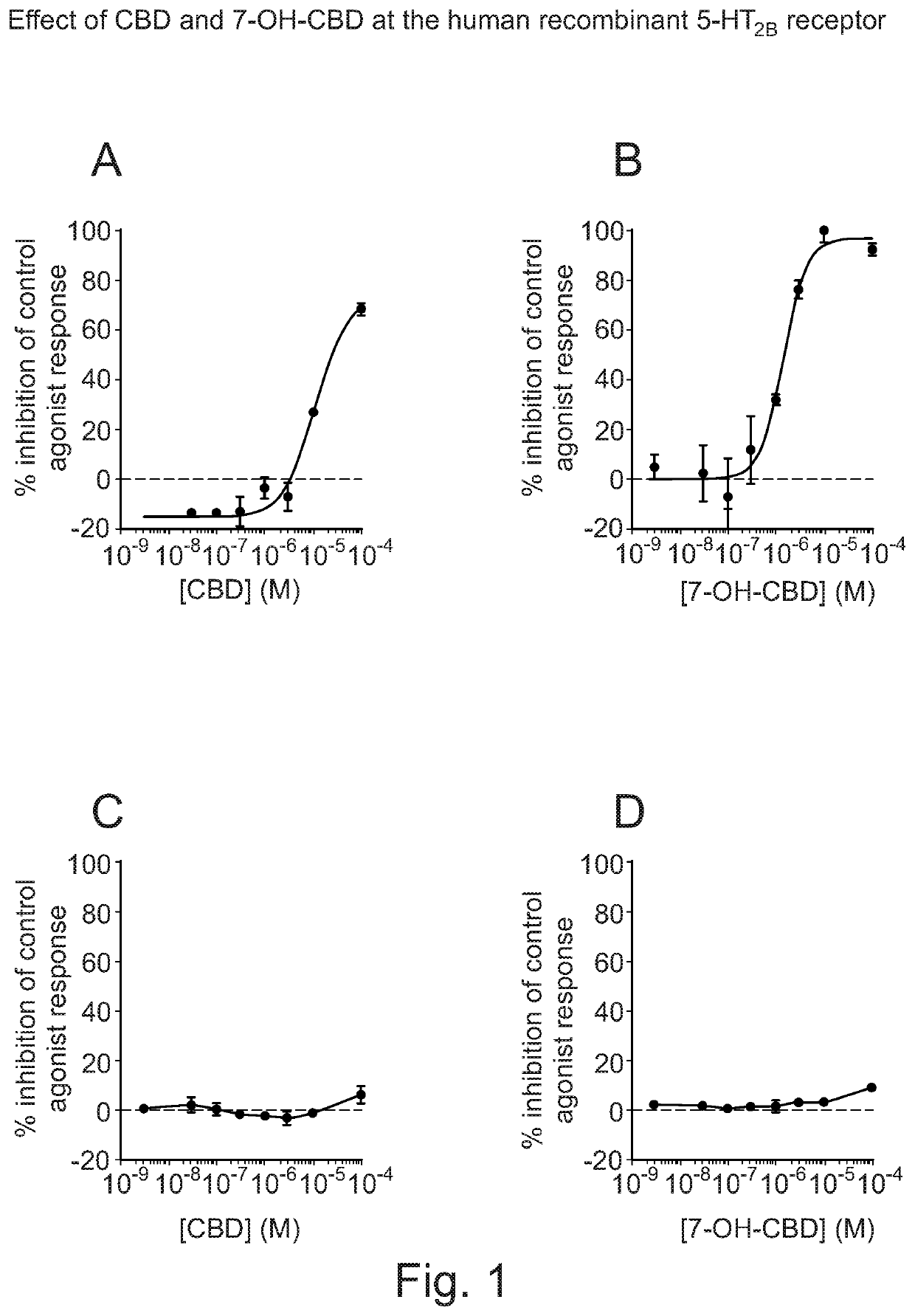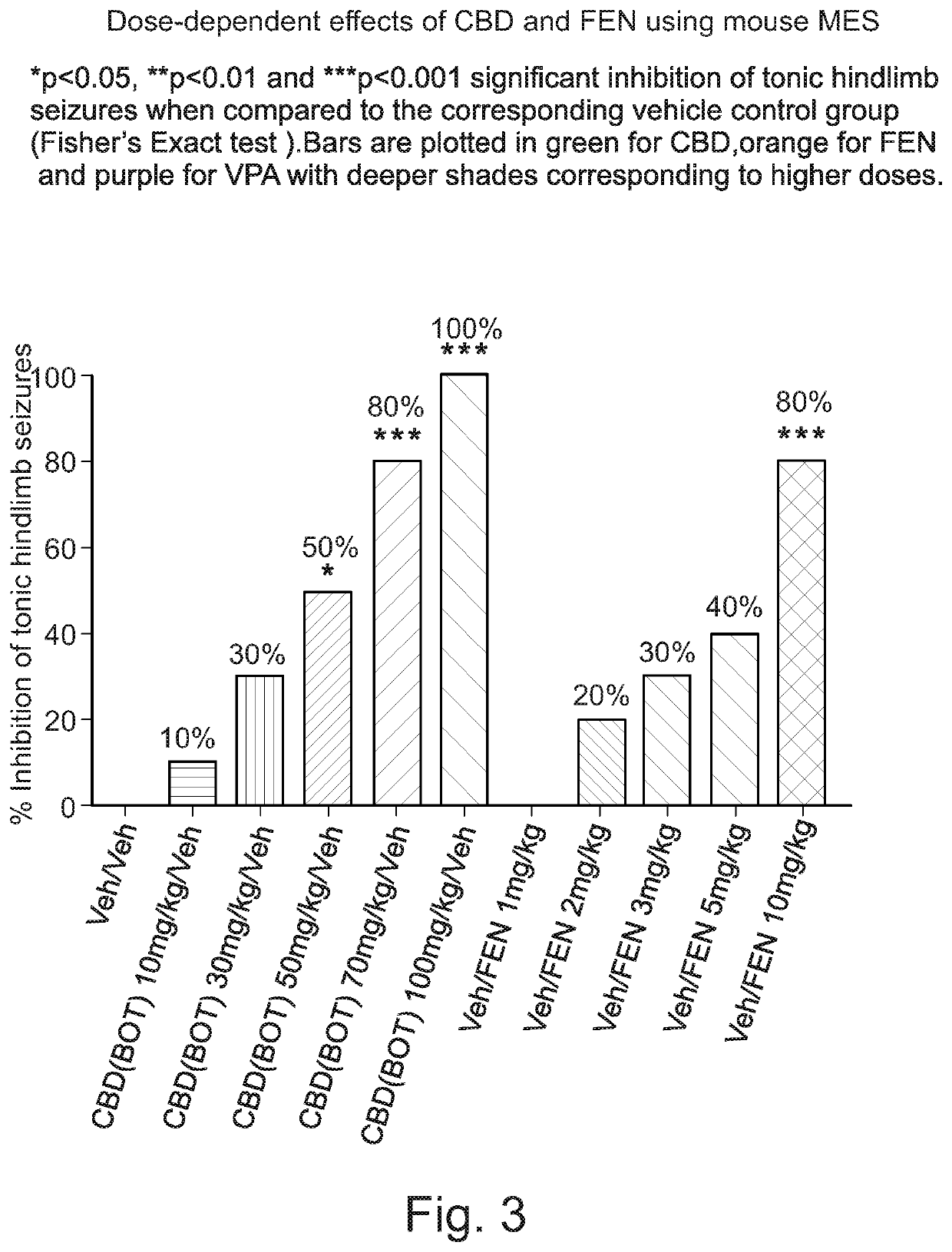Use of cannabidiol in combination with 5-HT2B receptor agonists or amphetamines in the treatment of epilepsy
a technology of cannabidiol and agonists, applied in the direction of nervous disorders, drug compositions, plant/algae/fungi/lichens ingredients, etc., can solve the problems of difficult treatment, inability to obtain seizure freedom, cognitive, behavioral and motor delays
- Summary
- Abstract
- Description
- Claims
- Application Information
AI Technical Summary
Benefits of technology
Problems solved by technology
Method used
Image
Examples
example 2
on of Cannabidiol with Fenfluramine Produces Synergistic Reduction in Seizures
[0092]The following example describes data produced from a combination of the cannabinoid CBD with the amphetamine derivative fenfluramine in a mouse model of seizure. Isobolographic analysis was undertaken to determine whether such a combination could produce a synergistic reduction in seizures.
Materials and Methods
[0093]The study was performed in two phases. Firstly, (Experiment A), a dose-dependent anticonvulsant effect of purified botanical CBD and fenfluramine (FEN) alone was demonstrated. Secondly, (Experiment B), drug-drug interactions (DDI) and anticonvulsant activities for CBD / FEN in combination were determined.
[0094]Experiment A was performed using 160 male, C57Bl6 mice, weighing between 20.1-30.1 g, and Experiment B was performed using 126 male, C57Bl6 mice, weighing between 19.2-26.1 g, purchased from a licensed breeder (Charles River, UK). There were no significant differences in animal weight...
experiment b
Percent Inhibition of Electroconvulsions by CBD / FEN Combination
[0112]CBD or FEN alone exerted no significant effect on the incidence of maximal electroshock seizures (MES) when compared to vehicle at any of the doses tested, which was consistent to the low dose effects in the previous study (Experiment A).
[0113]In contrast, CBD plus FEN (p<0.01) produced significant anticonvulsant effects when compared with vehicle at two (CBD / FEN) of the ratio-dose combinations tested (FIG. 4).
Isobolographic Analysis of DDI Based Upon CBD / FEN Doses
[0114]The three fixed ratios of CBD / FEN 1:3, 1:1 and 3:1 corresponded to theoretically additive EE50 values which, when adjusted to dose reflect ratios of 1:2.3 (ED55+ADD), 1:1 (ED50+ADD), and 3:1 (ED46+ADD). As such, there is sufficient difference between dose and exposure ratios to reveal distinct effects.
[0115]Median-effect curves for CBD and FEN doses derived potencies (Dm or ED50) of 33.2 mg / kg and 4.9 mg / kg. Simultaneously, m values of the dose-effe...
PUM
| Property | Measurement | Unit |
|---|---|---|
| w/w | aaaaa | aaaaa |
| w/w | aaaaa | aaaaa |
| seizure frequency | aaaaa | aaaaa |
Abstract
Description
Claims
Application Information
 Login to View More
Login to View More - R&D
- Intellectual Property
- Life Sciences
- Materials
- Tech Scout
- Unparalleled Data Quality
- Higher Quality Content
- 60% Fewer Hallucinations
Browse by: Latest US Patents, China's latest patents, Technical Efficacy Thesaurus, Application Domain, Technology Topic, Popular Technical Reports.
© 2025 PatSnap. All rights reserved.Legal|Privacy policy|Modern Slavery Act Transparency Statement|Sitemap|About US| Contact US: help@patsnap.com



